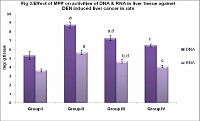Chemopreventive effect of Phyllanthus polyphyllus against N-nitrosodiethylamine induced liver tumors in wistar rats
Keywords:
Phyllanthus polyphyllus, Liver Tumor, N-nitrosodiethylamine, Lipid Peroxidation, AntioxidantsAbstract
The aim of the study is to evaluate the chemopreventive effect of methanol extract of Phyllanthus polyphyllus (MPP) against N-nitrosodiethylamine (DEN, 200mg/kg) induced experimental liver tumors in male wistar rats. Administration of Phyllanthus polyphyllus (200 and 400mg/kg) effectively suppressed liver tumor induced by DEN as revealed by decrease in DEN induced elevated levels of mitochondrial lipid peroxidation (LPO), deoxy ribonucleic acid (DNA), ribo nucleic acid (RNA) and liver weight. The extract produced an increase in mitochondrial enzymatic antioxidants (Superoxide dismutase (SOD), catalase (CAT) and glutathione peroxidase (GPx) and non enzymatic antioxidants (Reduced Glutathione (GSH)) levels when compared to liver tumor bearing animals. Our data suggest that MPP may extend its chemopreventive effect by modulating the levels of mitochondrial lipid peroxidation, DNA and RNA and liver weight and augmenting mitochondrial antioxidant defense system.
References
Peers PG and Linsell CA. Dietary
aflatoxins and liver cancer. A population
based study in Kenya. Br. J. Cancer.
;27:473-484.
Mathew KM. The Flora of the Tamilnadu
Carnatic, Vol. 3, the Rapinet Herbarium,
St. Joseph’s College, Trichirapalli.
;p.1468.
Rao YK, Fang SH and Tzeng YM. Antiinflammatory activities constituents
isolated from Phylanthus polyphyllus. J.
Ethnopharmacol. 2006;103:181-186.
Youkwan J, Srisomphot P and
Sutthivaiyakit S. Bioactive constituents of
the leaves of Phyllanthus polyphyllus. J.
Nat. Prod. 2005;68:1006-1009.
Rajkapoor B, Venugopal R, Sakthisekaran
D, Zhang HQ, Nishigaki I. Protective
effect of Phyllanthus polyphyllus on
human umbilical vein endothelial cells
against glycated protein-iron chelate
induced toxicity. J Medical Sciences.
;7(6):961-968.
Rajkapoor B, Sankari M, Sumithra M,
Anbu J, Harikrishnan N, Gobinath M,
Suba V and Balaji R. Antitumour and
cytotoxic effect of Phyllanthus
polyphyllus on Ehrlich ascites carcinoma
and human cancer cell lines. Bioscience,
Biotechnology, and Biochemistry.
;71:2177-2183.
Rajkapoor B, Venugopal Y, Anbu J,
Harikrishnan N, Gobinath M and
Ravichandran V. Protective effect of
Phyllanthus polyphyllus on
acetaminophen induced hepatotoxicity
in rats. Pak J Pharm Sci. 2008;21(1):57-
Yoshiji H, Nakae D, Kinugasa T, Matsuzaki
M, Denda A, Tsujii T and Konishi Y.
Inhibitory effect of dietary iron deficiency on
the induction of Putative preneoplastic foci
initiated with diethylnitrosamine and
promoted by Phenobarbital. Br. J. Cancer.
;64: 839-842.
Devasagayam TPA and Tarachand U,
Decreased lipid peroxidation in the rat
Kidney during gestation. Biochem.
Biophys. Res.Commun. 1987;56:836-842.
Marklund S, Marklund G. Involvement of
superoxide anion radical in the
autoxidation of pyrogallol and a
convenient assay for superoxide
dismutase. Eur. J. Biochem. 1974;47:469-
Sinha AK. Colorimetric assay of catalase.
Anal. Biochem. 1972;47:389-394.
Rotruck JT, Pope AL, Ganther HL and
Swanson AB. Selenium: biochemical
role as a component of glutathione
peroxidase. Science. 1973;179:588-590.
Staal GEJ, Visser J and Veeger C.
Purification and properties of
glutathione reductase of human
erythrocytes. Biochim. Biophys. Act.
;185:39-48.
Moron MS, DePierre JW, Manrervik B.
Levels of glutathione, glutathione
reductase and glutathione-S-transferase
activities in rat lung and liver. Biochim
Biophys Acta. 1979;582:67-8.
Schneider WC. In: Methods in
Enzymology, Colowick S.P. and
KaplanN.O. (eds.), Vol.III, Academic
Press, New York. 1957;680.
Burton K. A study of the conditions and
mechanism of the diphenylamine
reaction for the colorimetric estimation of
deoxyribonucleic acid. Biochem. J.
;62:315-323.
Rawal UM, Patel US, Rao GN and Desai
RR. Clinical and biochemical studies on
cateractous human lens III. Quantitative
study of protein, RNA and DNA. Arogya
J. Health. Sci. 1977;3: 69-72.
Hong WK and Sporn MB. Recent
advances in chemoprevention of cancer.
Science. 1997;278:1073-1077.
Esterbauer H, Schaur RJ. Zollner
Chemistry and biochemistry of 4-
hydroxynonenal, malonaldehyde and
related aldehydes. Free Rad Biol Med.
;11:81–128.
Hietanen E, Ahotupa M, Bartsch H, et al.
Lipid peroxidation and chemically
induced cancer in rats fed lipid rich diet.
In carcinogenesis and Tumor progression,
vol. 4, Lapis K, Kcharst S (eds),
Akademiaikiado: Budapest. 1987;9–16.
Scholz W, Schutze K, Kunz W, Schwartz
M. Phenobarbital enhances the formation
of reactive oxygen in neoplastic rat liver
nodules. Cancer Res. 1990;50:7015–7022.
Thirunavukkarasu C, Prince Vijeya Singh
J, Selvendiran K, Sakthisekaran D.
Chemopreventive efficacy of selenium
against N-nitrosodiethylamine-induced
hepatoma in albino rats. Cell Biochem
Funct. 2002;19:265–271.
Nakae D, Kombashi Y, Akai H.
Involvement of 8-hydroxyguanine
formation in the initiation of rat liver
carcinogenesis by low dose levels of Nnitosodiethylamine. Cancer Res.
;57:1281–1287.
Torel J, Cillard J, Cillard P. Antioxidant
activity of flavonoids and reactivity
with peroxyl radical. Phytochemistry.
;25:383–385.
Kono Y, Fridovich I. Superoxide radicals
inhibit catalase. Jour Biol Chem.
;257:5751–5754.
Thirunavukkarasu C, Sakthisekaran D.
Effect of Selenium on Nnitrosodiethylamine induced multistage
hepatocarcinogenesis with reference to
lipid peroxidation and enzymic
antioxidants. Cell Biochem Funct.
;19:27–35.
Sumathi R, Baskaran G, Varalakshmi P.
Effect of Dl- -lipoic acid on tissue redox
state in acute cadmium-challenged tissues.
J Nutr Biochem. 1996;7:85–92.
Galati G, Chan T, Wu B, O’Brien PJ.
Glutathione dependent generation of
reactive oxygen species by the peroxidise
catalysed redox cycling of flavonoids.
Chem Res Toxicol. 1999;12:521–525.
Clemens MR, Walker HD. Lipid
peroxidation in erythrocytes. Chem Phys
Lipids. 1987;45:251–268.
Yu BP. Cellular defence against damage
from reactive oxygen species.
Physiological Reviews. 1994;74:136–162.
Gallagher RE. Biochemistry of
Neoplasia. In: Comprehensive Text Book
of oncology. Moosa AR, Robson MC,
Schimpff SC. (eds), Williams and
Wilkins, Baltimore, USA. 1986;36-45.
Ellis CN, Burnette JJ, Sedlack R,
Dyas C and Balkemore WS. Prognostic
applications of DNA analysis in solid
malignant lesions in humans. Surgery.
;173:329-342.
Yukiaki Kuroda and Yukihiko Hara.
Antimutagenic and anticarcinogenic
a c t i v i t y o f tea p o l y p h e n o l s .
Mutation. Research. 1999;436:69-97.



